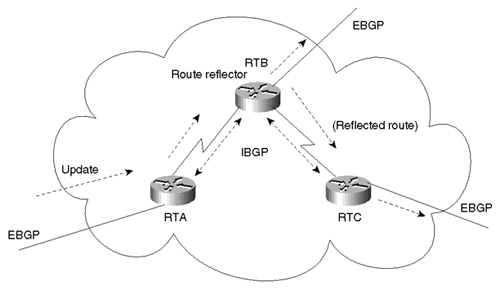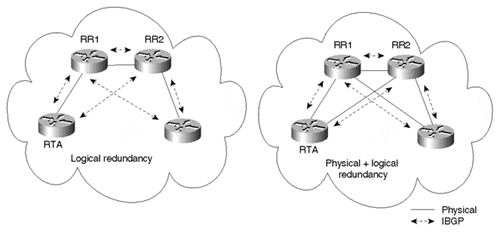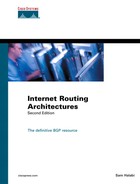Route Reflectors
In some Internet service provider (ISP) networks, the internal BGP mesh can become quite large (more than 100 internal BGP sessions per router), which strongly suggests that some new peering mechanism be implemented. The route reflector[1] concept is based on the idea of specifying a concentration router to act as a focal point for internal BGP sessions. Multiple (client) BGP routers can peer with a central server (the route reflector), and then route reflectors peer with one another. Although the BGP rule states that routes learned via one IBGP speaker can't be advertised to another IBGP speaker, route reflection allows the route reflector servers to "reflect" routes as described later, thereby relaxing the IBGP full-mesh constraints.
Route reflectors are recommended only for ASs that have a large internal BGP mesh. The route reflector concept introduces processing overhead on the route reflector server and, if configured incorrectly, might introduce routing loops and routing instability. As a result, route reflectors are not recommended for every topology.
That said, route reflection does introduce some advantages on both the route reflector servers and their clients. For example, a route reflector server implementation could be optimized to simply copy UPDATE messages when sending to multiple peers, rather than generating unique messages per peer. In addition, the clients normally peer with only the local route reflector server, thereby significantly decreasing the number of sessions they're required to maintain.
Tip
See the section Route Reflectors in Chapter 12.
Internal Peers Without Route Reflectors
Without route reflectors, BGP speakers in an AS will have a logical full mesh. We discussed this behavior earlier in this book; the following illustration is just a reminder. In Figure 9-1, RTA, RTB, and RTC form an internal BGP logical full mesh. Each router acts as a BGP peer with the other two routers. RTA and RTB are physically connected, as are RTB and RTC. No physical connection exists between RTA and RTC.
Figure 9-1. Internal Peers in a Normal Full-Mesh Environment

When RTA receives an update from an external peer, it forwards the update to its two internal peers, RTB and RTC. Note that although there is no physical connectivity between RTA and RTC, RTA manages to pass the update to RTC via the BGP peering session. RTB and RTC, in turn, pass the update to their external peers.
The UPDATE message that RTB receives from RTA is not readvertised to RTC because RTC is an internal peer, and the UPDATE message RTB received was from an internal peer (RTA). Without the internal BGP session between RTA and RTC, RTC would never get the update; hence, the full IBGP mesh is required.
Internal Peers with Route Reflectors
The route reflector acts as a concentration point for other routers referred to as clients. The clients peer with the route reflector and exchange routing information with it. In turn, the route reflector passes (or reflects) the information between clients and to other IBGP and Exterior Border Gateway Protocol (EBGP) peers.
In Figure 9-2, RTB is configured as a route reflector with two clients, RTA and RTC. RTA gets an update from an external peer and forwards it to RTB. RTB reflects the update from client RTA to client RTC. In this configuration, a peering session between RTA and RTC should not be configured, because the route reflector is propagating the BGP information from RTA to RTC.
Figure 9-2. Internal Peers Using a Route Reflector

In an AS where the administrator would have to build a substantial number of BGP sessions between routers, the route reflector concept provides a very helpful and scalable solution to the problem.
Naming Conventions and Rules of Operation
The route reflector is a router that performs the route reflection function. The IBGP peers of the route reflector fall under two categories—clients and nonclients. A route reflector and its clients form a cluster. All peers of the route reflector that are not part of the cluster are nonclients. Figure 9-3 illustrates these components.
Figure 9-3. Route Reflection Process Components

Nonclients (standard IBGP speakers) are still required to be fully meshed with one another and the route reflector because they follow the normal IBGP advertisement rules, although they no longer need to peer with the clients of the route reflectors. Clients should not peer with internal speakers outside their associated cluster. As you can see, these conditions have been met for the clients and nonclients in Figure 9-3.
The route reflector function is implemented only on the route reflector; all clients and nonclients are normal BGP peers that have no notion of the route reflector. Route reflector clients are considered as such only because the route reflector lists them as clients.
Any route reflector that receives multiple routes for the same destination employs the usual BGP decision process to pick the overall best path. The best path would be propagated inside the AS based on the following rules of operation:
-
If the route is received from a nonclient peer, reflect to clients only.
-
If the route is received from a client peer, reflect to all nonclient peers and also to client peers.
-
If the route is received from an EBGP peer, reflect to all client and nonclient peers.
Because route reflection is a concept that applies only internally to an AS, routers external to the AS, which would receive UPDATEs via EBGP, are considered nonclients and follow normal nonclient behavior with respect to sending and receiving UPDATEs.
Redundancy Issues and Multiple Route Reflectors in an AS
With the lack of a full BGP mesh inside the AS, redundancy and reliability become issues. If a route reflector fails, clients will be isolated. Redundancy requires the existence of multiple route reflectors in a cluster where clients can simultaneously peer with multiple routers. If one route reflector fails, the other(s) should still be available.
The importance of complementing logical redundancy with physical redundancy cannot be overstated. It does not make sense to build route reflector redundancy if the physical redundancy itself does not exist. The logical redundancy arrangement on the left in Figure 9-4 shows RTA as the client of both RR1 and RR2. (RR stands for route reflector in this figure and those that follow.) RTA is peering with both route reflectors in an effort to create a redundant link. Unfortunately, if the connection to RR1 is broken, or if RR1 itself fails, RTA is isolated. The logical connectivity between RTA and RR2 is of no practical use; it is simply more memory and processing overhead.
Figure 9-4. Comparison of Logical and Physical Redundancy Solutions

The physical redundancy configuration on the right in Figure 9-4 illustrates how logical redundancy can be backed up with physical redundancy. In the event of a failure in the link to RR1, RTA can reach RR2.
Route Reflection Topology Models
National networks are usually laid out in concentration points across geographical regions. Providers have points of presence (POPs), sometimes called hubs, in different regions in the U.S. with high-speed links connecting different locations in a partial-mesh topology. The route reflector concept can be used to logically interconnect the routers running BGP in a pattern that follows the physical topology. Figure 9-5 illustrates a complex arrangement featuring route reflectors.
Figure 9-5. Complex Multiple Route Reflector Environment

Except for the fact that the route reflector needs to keep up with more IBGP sessions than client routers, any router could be configured as a route reflector. Your physical topology should be the main indicator of which router would be the best route reflector. Also, because the clients aren't required to peer with lots of other IBGP routers, more resources are available for handling EBGP connections.
In Figure 9-5, AS100 is divided into three clusters: San Francisco, Dallas, and New York. The Dallas cluster has multiple RRs for redundancy. RTA and RTD physically connect San Francisco to New York. It makes sense to follow the actual physical traffic flow in selecting RRs, so RTA and RTD are the obvious choices for RRs in the Dallas cluster.
In San Francisco, router RTC physically connects San Francisco to Dallas, so RTC would be the best candidate to become a RR. The same reasoning applies for the New York cluster: RTE physically connects New York to Dallas and is the best candidate for a RR.
The Route Reflector Preserves IBGP Attributes
The route reflector concept does not change IBGP behavior—the route reflector is not allowed to modify the attributes of the reflected IBGP routes. The NEXT_HOP attribute, for example, remains the same when an IBGP route is exchanged between RRs. This is necessary to avoid loops inside the AS.
Figure 9-6 illustrates why the RR should not modify the attributes of the reflected IBGP routes. The NEXT_HOP attribute is used as an example. Figure 9-6 focuses on the portion of the network where Dallas connects to San Francisco.
Figure 9-6. The Route Reflector Preserves IBGP Attributes

Although the route reflection rules state that a route reflector should not modify any of the attributes, many implementations do permit this and/or filtering to occur. In practice, use care if you must perform actions of this nature.
Assume that RTB rather than RTA is specified as the route reflector and that an IBGP session is configured between RTB (2.2.2.2) and RTC (1.1.1.1). This looks odd, because RTA is physically passing the traffic, while logically RTB is reflecting the BGP routes between RTA and RTC. RTB will receive the prefix 192.213.11.0/24 from its IBGP neighbor RTC with a next hop of 1.1.1.1. RTB will reflect the route to its client RTA with the next hop 1.1.1.1 also. This is the standard, desired behavior for route reflection.
On the other hand, if RTB were to change the next hop to its IP address, 2.2.2.2, RTA would try to use RTB to reach destination 192.213.11.0/24. A loop would occur between RTA and RTB, because RTA will use the next hop of RTB. The result is that RTA will forward traffic to RTB. Subsequently, RTB will forward the traffic back to RTA to reach the final destination. This hypothetical situation exemplifies why the route reflector must not change IBGP attributes.
It is worth mentioning again that route reflectors propagate only the best route to a given destination. In other words, if a route reflector learns the same prefix from multiple client peers, only one path will be propagated to other peers. Therefore, when route reflectors are used, the number of paths available to reach a given destination will likely be lower than that of a full-mesh configuration. Due to this behavior, it is again advised that route reflector topologies resemble that of the physical topology, or the potential for suboptimal routing might occur.
Avoiding Loops
BGP relies on the information in the AS path to facilitate loop detection. A BGP update that attempts to reenter the AS it was originated from will be dropped by the border router of the source AS.
With the introduction of route reflectors, there is a potential for routing loops within an AS. A routing update that leaves a cluster may reenter the cluster. Loops inside the AS cannot be detected by the traditional AS path approach because routing updates do not have an originating AS path signature. Therefore, when route reflectors are deployed, BGP offers two extra measures for loop avoidance inside the AS—using an ORIGINATOR_ID and using a CLUSTER_LIST.
Using an ORIGINATOR_ID
The ORIGINATOR_ID is a 4-byte, optional, nontransitive BGP attribute (type code 9). This attribute carries the ROUTER_ID of the route's originator in the local AS and is to be added to the UPDATE message by the route reflector. If the update comes back to the originator because of poor configuration, the originator should discard it.
The CLUSTER_LIST
The CLUSTER_LIST is an optional, nontransitive BGP attribute (type code 10). Each cluster is represented with a CLUSTER_ID.
A CLUSTER_LIST is a sequence of CLUSTER_IDs that contain path information regarding the list of clusters that an UPDATE has traversed. When a route reflector sends a route from its clients to nonclients outside the cluster, it appends the local CLUSTER_ID to the CLUSTER_LIST, or creates the list if one is not present. If the route reflector receives an UPDATE whose CLUSTER_LIST contains the local CLUSTER_ID value, the UPDATE message should be discarded. Thus, the CLUSTER_LIST provides loop avoidance inside an AS, whereas the AS_PATH list, discussed earlier, facilitates loop avoidance for UPDATEs traversing multiple, external ASs.
See the configuration guidelines in the section Route Reflectors in Chapter 12.
Route Reflectors and Peer Groups
Recall from Chapter 6, "Tuning BGP Capabilities," that a peer group is a group of BGP neighbors that share similar routing policies. Previously, route reflectors could be used only in conjunction with peer groups when all route reflector clients within a cluster were fully meshed. The reason can best be described through the following example. In a typical route reflection situation, Router A learns a prefix from Router B. Subsequently, Router A sends an UPDATE message containing WITHDRAWN ROUTES information back to Router B to poison that route. In other words, Router A informs Router B that this prefix is unreachable via A. This prevents a route loop situation in which A claims that a prefix is reachable via B, and B claims it is reachable via A.
In a peer group, the same UPDATE message (with subsequent WITHDRAWN ROUTES information) is sent to all members of the group. In a peer group/route reflector situation, a route reflector that learns a prefix from one of the clients and attempts to poison that route ends up withdrawing that prefix from all the other clients. Because the clients are not talking to one another via BGP, that prefix is lost. Therefore, an IBGP mesh between the clients of a route reflector is necessary so that other clients will learn the prefix directly from the originator. Even with this design, the network administrator avoids building a full IBGP mesh between all IBGP routers in the AS by concentrating the mesh between route reflectors and clients (versus between clients within a cluster).
Fortunately, IOS has removed the full-mesh requirement on route reflector clients. Currently, clients of a route reflector configured under a peer group are not required to be fully meshed.
With the use of peer groups, the AS design would look like rings of fully meshed BGP speakers. Route reflectors are fully meshed among each other, and clients are only required to peer with the route reflectors. Figure 9-7 illustrates such an environment; each circled area represents a distinct peer group and route reflector cluster. In contrast, Figure 9-8 demonstrates what would be required without the use of route reflectors.
Figure 9-8. Full-Mesh BGP Topology

In conclusion, the route reflector concept is growing in popularity for large networks because it is both a simple and a scalable approach that does not require substantial overhead. Furthermore, migrating from a nonroute reflector to a route reflector design is easy. Only those routers intended to be route reflectors need to be modified; all other routers operate as usual. In addition, routers that do not implement the route reflector behavior, such as clients or nonclients, could be part of the AS with no loss of BGP routing information.

